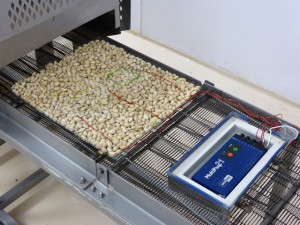Project Aims To Create Guidelines For Pistachio Pasteurization Validation

Salmonella-inoculated and instrumented pistachios enter the pilot-scale oven in the Michigan State University Biosafety Level-2 Pilot Plant, as part of a research project aimed at improving process validation methods.
Photo: Michael James
Pistachio processors already go to great lengths to ensure their product is safe for consumers, but the Food Safety Modernization Act (FSMA) will mean they need to take their food safety measures a step further.
Under FSMA, pistachio processors will have to scientifically validate the pasteurization processes they use to prevent Salmonella contamination. Bradley Marks, professor in the Department of Biosystems and Agricultural Engineering at Michigan State University, is leading a two-year research project to study the variabilities in different pasteurization processes, and how those processes can be validated. The primary focus will be on roasting.
“At this point in our world, Salmonella is a hazard that is reasonably likely to possibly occur in low-moisture products like nuts. It’s happened before, so we have to assume it’s possible it could happen again,” Marks says. “That being the case, the proposed rules of FSMA require that the processor have a validated process that they can document that they’ve shown achieves the food safety objective.”
Marks and his colleagues are currently working on lab-scale research to evaluate the effects of the pasteurization process and product conditions on the resistance of Salmonella to heating. “We’re doing some mathematical modeling so we can understand the rate of Salmonella activation as a function of temperature, time, and conditions of the product or the process itself,” Marks says.
The second part of the project will involve similar work on a pilot scale. “We have a system where we can inoculate pistachios with Salmonella and subject them to a process like a flatbed roaster,” Marks says. “So we are looking at validating that our prediction of the inactivation of Salmonella is correct, and that a non-pathogenic surrogate (Enterococcus faecium) also is reliable as a means to validate the process.”
The researchers are also working to understand the variability involved in the processes. “There’s always some degree of variability or uncertainty in any real-world process, and we want to make sure we have a very good grasp of that,” Marks says.
Current research has involved roasting nuts contaminated with Salmonella in conditions similar to what would occur in a commercial system to study how different variables such as temperature, humidity and air velocity might affect the outcome. The research is still in the early stages, but Marks hopes to be done with lab tests by the end of December so that pilot-scale work can begin in January.
What It Means For Producers
Marks is working closely with Linda Harris, co-principal investigator for the Western Center for Food Safety at the University of California, Davis, to develop guidelines and on-site workshop training for pistachio processors. The guidelines and training will focus on what needs to be measured and documented to meet the FSMA requirements. “Although we’re focused on the entire industry, we want to make sure that we’re providing information that’s particularly useful for processors that don’t necessarily have the resource staffing to develop those kinds of materials in-house,” Marks says. “We can provide that kind of support to connect the dots between our basic understanding of Salmonella in these kinds of products and then the real-world aspect of trying to validate a process.”
He adds that the goal is to create guidelines that are very pistachio-specific. “It’s kind of a cookbook,” he says. “Here are the steps to follow to achieve a validation passed at the end with documentation that will be sufficient and reliable.”










